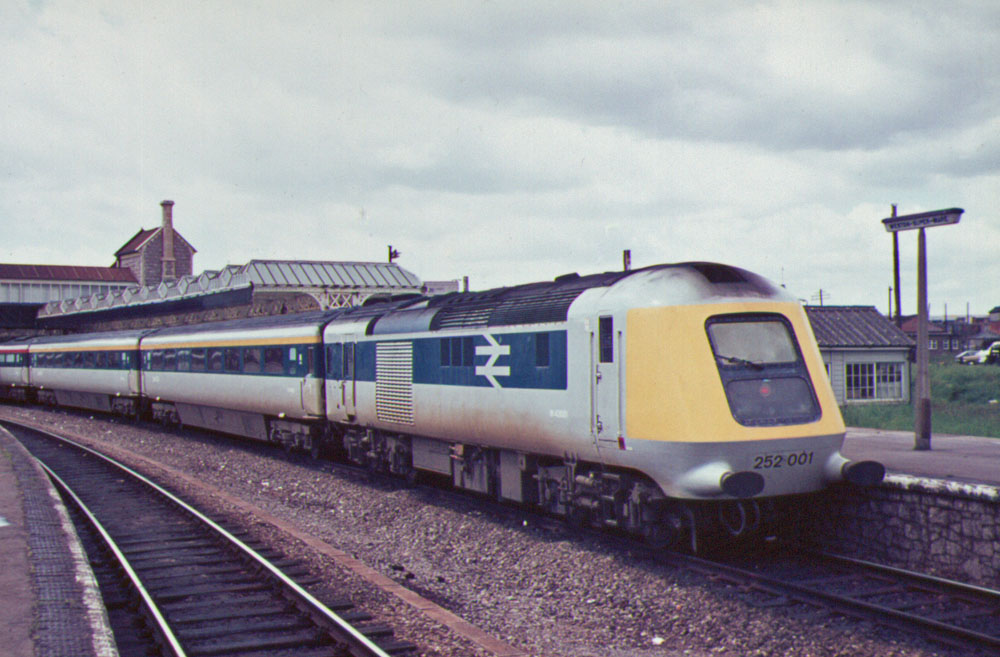- British Rail Class 252
Infobox Train
name = color|white|British Rail Class 252
background = #012545
imagesize = 300px
caption = Prototype HST 252 001 atWeston-super-Mare in1975 .Manufacturer =
BREL Crewe
Factory =
Family =
Built =
Refurbishment =
Replaced =Formation = Two power cars flanking 10 Mark 3 coaches
Designation = 252 001
Operator = British Rail Western Region
Depots =
LinesServed =yearconstruction = 1972
yearservice =
yearscrapped =
numberconstruction =
numberbuilt = 1 trainset
numberservice = 0
numberscrapped =CarBody =
CarLength =
CarWidth =
CarHeight =
floorheight =
platformheight =
entrylevelorstep =
art-sections =
doors =MaxSpeed = convert|125|mph|km/h|abbr=on|lk=on
Weight =
Capacity =
Acceleration =
Deceleration =
Traction =
Engine =Paxman Valenta 12RP200L, 2 off
Power =
Transmission =
Auxiliaries =
Power-supply =
Gauge = RailGauge|sg|lk=on|al=on
Voltage =
Brakes =
SafetySystem =Class 252 was the classification allocated to the prototype
High Speed Train unit, numbered 252001.History
When originally built, in 1972, the prototype
High Speed Train (HST) units were considered to be formed of two locomotives at either end of a rake of carriages. As a result, the power cars were designated Class 41 and numbered 41001/41002, while the carriages were given numbers in the new Mark 3 carriage number series.Shortly after their introduction, it was decided to classify the unit as a Diesel Electric Multiple Unit. It was allocated Class 252, and the whole formation was renumbered into a new carriage number series for HST and
Advanced Passenger Train vehicles (4xxxx). Two coaches were not included in the renumbering (one Trailer First and one Trailer Second), as these were transferred for use in theRoyal Train as part of its upgrade before Queen Elizabeth II's Silver Jubilee. The power cars were allocated numbers in the 43xxx series, and the two prototype cars took the numbers 43000/43001. Thus, the production-run cars were numbered from 43002 onwards.Ironically, the situation reversed again in the 1980s, and the production power cars were then considered to be class 43, as this time round no power car or carriage was renumbered. By this time, the prototype cars had been transferred into departmental (non-revenue earning) service and had taken numbers in the departmental carriage 975xxx series, so they were not involved in this redesignation, and they retained their departmental carriage numbers rather than being transferred to the departmental locomotive list.
The former 41002/43001 has now been scrapped, but the other prototype loco, 41001/43000, has been preserved as part of the National Collection, held at the
National Railway Museum , York. Of the passenger-carrying vehicles, all remain in use on the mainline, except for one of the former restaurant cars, which was scrapped in 1993, whilst many other vehicles since been scrapped due to other accidents.Formation
The vehicles that made up the prototype High Speed Train are listed below, together with their current identity and use:
References
External links
* [http://www.traintesting.com/HST_prototype.htm Testing the prototype HST ]
Wikimedia Foundation. 2010.
